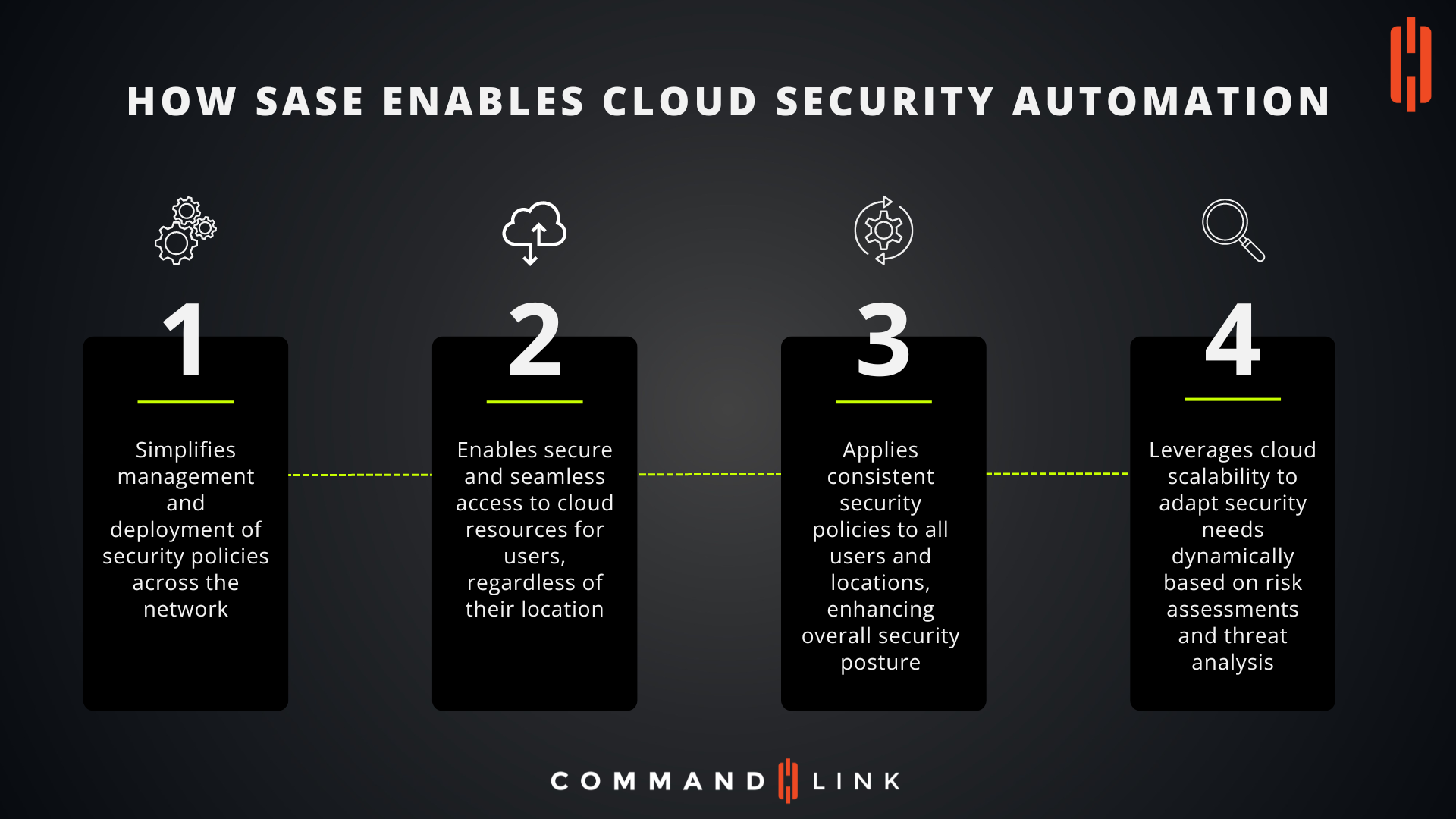Platform
Platform
Everything you need to run a secure global network—in a single system.
Solutions
Solutions
Learn how our solutions were designed to help you scale your IT resources
Company
CommandLink
Let's talk about how we can help you!
Partners

1. Simplifies Management and Deployment of Security Policies Across the Network
One of the most significant advantages of SASE is its ability to streamline the management and deployment of security policies across an organization's network. In traditional network security models, policies are often fragmented, with different systems and locations requiring separate configurations. This not only increases complexity but also introduces the risk of inconsistencies and vulnerabilities.
SASE addresses this issue by unifying network and security functions into a single cloud-based service. This consolidation allows for centralized management, where security policies can be defined, deployed, and enforced uniformly across all network segments. IT teams can now manage their security infrastructure with greater efficiency, reducing the administrative burden and minimizing the potential for human error. As a result, security policy updates can be rolled out swiftly across the entire organization, ensuring that the network remains protected against the latest threats.
Moreover, SASE's automation capabilities further enhance management efficiency. By leveraging automation tools, organizations can automate repetitive tasks, such as policy updates, monitoring, and compliance checks. This not only frees up valuable IT resources but also ensures that security policies are consistently applied, even as the network evolves.
2. Enables Secure and Seamless Access to Cloud Resources for Users, Regardless of Their Location
In today's globalized and remote work environment, providing secure and seamless access to cloud resources is critical. Employees, partners, and customers often need to access sensitive data and applications from various locations and devices. Traditional VPNs and perimeter-based security models struggle to keep up with these demands, leading to bottlenecks and potential security gaps.
SASE transforms this approach by integrating identity-driven security and access controls directly into the network fabric. It ensures that users can access the resources they need, regardless of their location, without compromising security. Through the use of technologies such as Zero Trust Network Access (ZTNA) and cloud-based firewalls, SASE verifies the identity of users and devices before granting access, ensuring that only authorized individuals can interact with critical assets.
This seamless access is further enhanced by SASE's ability to dynamically route traffic based on user location, application, and security posture. By optimizing the path data takes from the user to the cloud, SASE reduces latency and improves the overall user experience. Whether employees are working from the office, home, or on the go, they can rely on consistent and secure access to the resources they need.
3. Applies Consistent Security Policies to All Users and Locations, Enhancing Overall Security Posture
A significant challenge for organizations operating in multiple regions or with a distributed workforce is maintaining a consistent security posture. Disparities in security policies between locations can create vulnerabilities, leaving the organization exposed to potential threats.
SASE solves this problem by applying consistent security policies across all users and locations. With its cloud-native architecture, SASE ensures that security policies are enforced uniformly, regardless of where users are located or how they connect to the network. This consistency is crucial in maintaining a strong security posture, as it eliminates gaps that could be exploited by attackers.
Additionally, SASE's centralized policy management enables organizations to define security rules that align with their business objectives and regulatory requirements. These rules can then be automatically applied across the entire network, ensuring that every user and device adheres to the same security standards. This not only simplifies compliance but also reduces the risk of data breaches and other security incidents.
Furthermore, SASE provides visibility into network traffic and user activity, allowing security teams to monitor and respond to threats in real time. By leveraging advanced analytics and machine learning, SASE can detect and mitigate potential risks before they escalate, ensuring that the organization's security posture remains robust.
4. Leverages Cloud Scalability to Adapt Security Needs Dynamically Based on Risk Assessments and Threat Analysis
The dynamic nature of cloud environments requires security solutions that can scale and adapt to changing needs. Traditional security models often struggle to keep pace with the rapid growth of cloud services and the evolving threat landscape.
SASE leverages the scalability of the cloud to provide flexible and adaptive security. As an organization's needs change—whether due to an increase in users, the deployment of new applications, or emerging threats—SASE can dynamically adjust security controls to meet these demands. This scalability is particularly beneficial for organizations experiencing rapid growth or those that need to respond quickly to new risks.
One of the key features of SASE is its ability to perform continuous risk assessments and threat analysis. By analyzing network traffic, user behavior, and threat intelligence in real time, SASE can identify potential vulnerabilities and automatically adjust security policies to mitigate them. This proactive approach to security ensures that organizations are always prepared to defend against the latest threats.
Moreover, SASE's cloud-based architecture allows for the seamless integration of new security technologies and services. As the threat landscape evolves, organizations can easily incorporate advanced security measures, such as AI-driven threat detection or automated incident response, into their SASE framework. This future-proof approach ensures that security remains effective and up-to-date, even as the organization grows and changes.
SASE represents a paradigm shift in how organizations approach cloud security. By simplifying the management and deployment of security policies, enabling secure access for users regardless of location, applying consistent security policies, and leveraging cloud scalability, SASE empowers organizations to automate and enhance their security posture in the cloud era. As the digital landscape continues to evolve, SASE provides the agility and robustness needed to protect against emerging threats and ensure the seamless operation of cloud-based services.